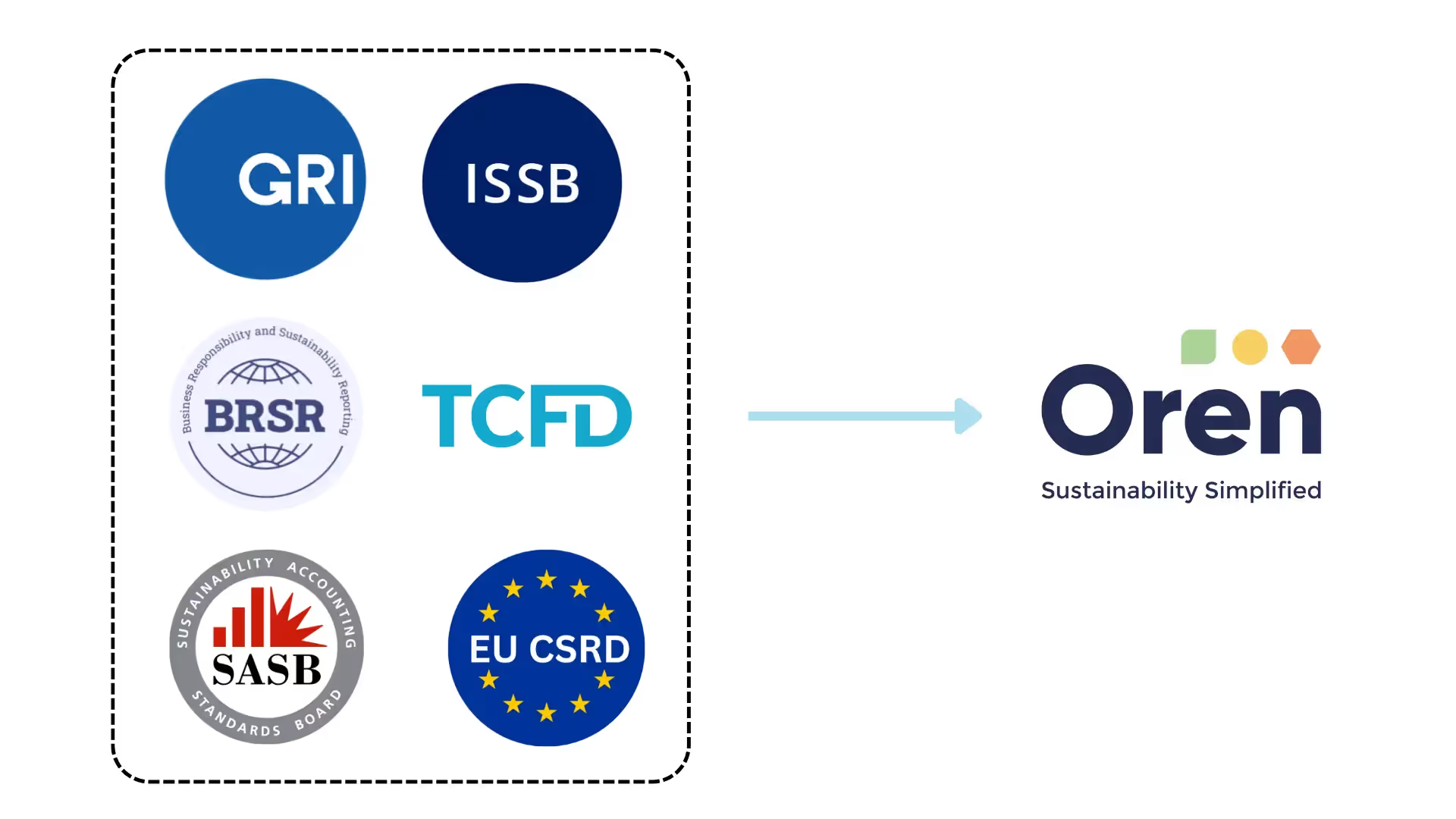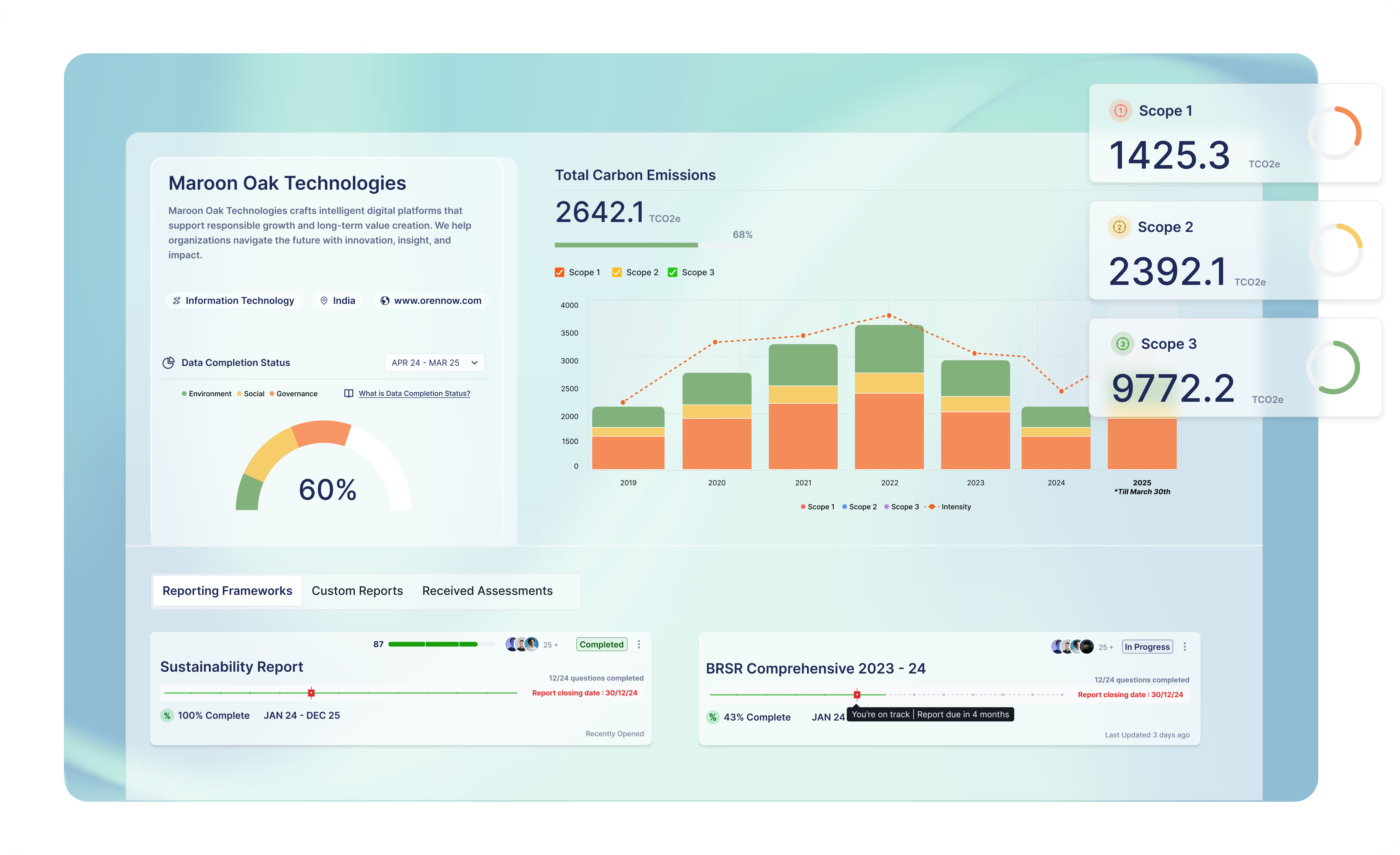ESG Frameworks Explained: How To Choose The Right One

Selecting the appropriate Environmental, Social, and Governance (ESG) reporting framework is a crucial step for any organisation aiming to demonstrate its commitment to sustainability and responsible business practices. With numerous ESG reporting frameworks and standards available, each offering different focuses, methodologies, and reporting requirements, the process can be complex and overwhelming. This blog aims to demystify the selection process, providing a comprehensive guide to help you navigate the landscape of ESG frameworks and choose the one that best aligns with your company's unique goals, values, and operational context.
What is an ESG Framework?
ESG frameworks are a structured set of guidelines, standards and principles. Companies use them to disclose Environmental, Societal, and Governance (ESG) based aspects of the business. These frameworks help organisations report and assess ESG-related performance, risks and opportunities. They provide qualitative elements, metrics, formats and reporting frequencies. Thus, they enable businesses to consistently communicate their ESG performance.
Various organisations, such as think tanks, nonprofit organisations, NGOs, stock exchanges, business groups and governments, create ESG frameworks. Some of the popular ESG assessment frameworks are:
1. Business Responsibility and Sustainability Reporting (BRSR)
2. Global Reporting Initiative (GRI)
3. Taskforce on Nature-related Financial Disclosures (TNFD)
Understanding ESG and Its Importance
ESG holds a key role in business growth and expansion owing to its ability to align businesses with societal expectations and ethical standards. It contributes to long-term stability through compliance with regulatory requirements and risk management.
1. Regulatory Pressure
Governments, global regulators and standard-setting bodies are mandating compliance reports. SEBI has mandated ESG disclosure for the top 1000 listed companies to provide the Business Responsibility and Sustainability Report (BRSR). Similarly, several regions, including the UK, EU, Australia, and Canada, have introduced mandatory or enhanced ESG disclosure frameworks.
2. Investor Trust
The disclosure encourages transparency with ESG data. It enhances stakeholder trust. The result is better access to capital as investors can use the transparent ESG metrics to evaluate long-term risks, value creation and resilience of the business.
3. Consumer Expectations
Businesses focusing on sustainability, environmental improvement, societal responsibility and other such aspects are widely chosen and accepted by the customers. The companies gain a competitive advantage and can expect to benefit from customer loyalty as well.

Why Use an ESG Framework?
There are several benefits to adopting ESG reporting frameworks:
1. Improves Stakeholder Confidence
ESG frameworks help companies address the growing expectations of stakeholders through compliance with global regulatory standards, fostering sustainability and via ethical business practices.
2. Transparency and Accountability
ESG reporting provides reliable information about a company’s practices, fostering trust and demonstrating accountability.
3. Access to Capital
Investors are increasingly focusing on ESG performance when making investment decisions, so a robust framework can help attract new investments.
4. Managing Risks and Opportunities
ESG frameworks help identify potential risks and opportunities, contributing to long-term business sustainability. This enables companies to mitigate risks such as reputational damage, regulatory fines, and supply chain disruptions.
ESG Reporting Frameworks vs. ESG Standards
The ESG framework provides guidance and best practices for companies on how to prepare and structure their information. The standards, on the other hand, offer specific insights about topics to cover, including the rules and metrics to follow. In simple terms, the framework acts as the reporting structure, while the standards define the content and measurement criteria.
The frameworks are flexible and offer high-level guidance and serve a wide set of stakeholders. The standards are measurable, prescriptive and standardised and serve primarily investment and capital market participants.
Here is how the Global Reporting Initiative (GRI) and the Sustainability Accounting Standards Board (SASB) complement each other.
Types of ESG Frameworks
The detailed insights into the types of ESG frameworks are as follows:
1. Regulatory Frameworks (Government-driven)
Government-driven regulatory ESG frameworks are mandatory for businesses to report on. These include the ones introduced by governments, regulators or stock exchanges. These frameworks are non-negotiable. They focus on ensuring:
a. Compliance
b. Transparency
c. Sustainability
d. Accountability
They also aim to align corporate behaviour with societal and environmental well-being. These frameworks are mainly for regulators and policymakers to enable them to:
a. Enforce laws
b. Monitor corporate accountability
c. Ensure compatibility across companies
Compliance with these frameworks is essential for businesses to avoid legal consequences.
Examples of Regulatory Frameworks
i. CSRD/ESRS (EU)
The European Union has introduced two initiatives, the Corporate Sustainability Reporting Directive (CSRD) and the European Sustainability Reporting Standard (ESRS). CSRD deals with reporting requirements and obligations of ESG topics such as employee well-being, greenhouse gas emissions and diversity and inclusion. ESRS offers a methodology and framework for reporting. It specifies the details and components of information and ESG data to be reported by the companies.
ii. BRSR (India)
Introduced by the Securities and Exchange Board of India (SEBI), the Business Responsibility and Sustainability Report (BRSR) framework is designed for Indian companies to disclose their ESG performance. BRSR is mandatory for the top 1000 listed companies in India. It aims to standardise ESG disclosures, enhance transparency and enable better decision-making for investors, regulators, and other stakeholders.
iii. SEC Climate Disclosures
It was introduced by the US Securities and Exchange Commission (SEC). The climate disclosure rule required the public companies to disclose climate-related risks, greenhouse gas emissions, governance details and financial impacts of climate-related events and transition activities. Although the rule was finalised in March 2024, currently, the implementation is on hold due to ongoing legal challenges.
2. Voluntary Frameworks (Investor-driven)
These frameworks offer companies the flexibility to choose and implement ESG practices that align with their objectives and values. They are optional but are widely adopted by companies to serve three main goals in their sustainability reporting:
a. Build credibility
b. Maintain transparency
c. Ensure compatibility
These frameworks provide guidelines rather than strict regulations. They allow for customisation based on unique circumstances and stakeholders.
The voluntary frameworks are for investors, financial analysts and shareholders. These frameworks focus on financial materiality and building investor trust. Subsequently, it helps companies attract capital and strengthen investor confidence.
Examples of Voluntary Frameworks
i. Sustainability Accounting Standards Board (SASB)
SASB sets standards for disclosing financially material sustainability information to investors. It offers sector-specific guidance on issues like greenhouse gas emissions and energy consumption, making it suitable for companies focused on investor transparency.
ii. Carbon Disclosure Project (CDP):
This voluntary framework invites companies to disclose their environmental impacts through task-specific annual questionnaires. These cover water security, deforestation and sector-specific questions.
The responses are scored as per the company's awareness, leadership and management reflecting the environmental performance and progress of the company.
i. Global Reporting Initiative (GRI)
GRI is an independent and international organisation specific for sustainability reporting. It helps them manage and communicate their environmental, economic and social impacts. The reports check the quality of information while supporting better accountability and transparency. It is the modular framework that offers an impact based approach for organisations.
ii. IFRS Sustainability Standards
ISSB, under the IFRS Foundation, released IFRS Sustainability Standards (IFRS S1 and S2) to improve global consistency and comparability in sustainability reporting.
- IFRS S1 sets out the general requirements for disclosure of sustainability-related financial information.
- IFRS S2 focuses on climate-specific disclosures, including risks, opportunities, and related targets.
These were released in 2023 and have been effective for periods beginning on or after 2024.
3. Benchmark / Management Frameworks (Internal & Strategic)
These frameworks act as guidelines and benchmarks that companies use internally to:
a. Design strategies
b. Manage performance
c. Measure sustainability progress
It allows systematic analysis of the company, which can be further reflected upon to identify the strengths and weaknesses. Accordingly, the businesses can plan the improvement methods.
The benchmark or management frameworks are designed for employees, internal management and broader stakeholders. They help businesses enhance their overall corporate strategy and serve as tools for business transformation rather than compliance.
Examples of Benchmark/Management Frameworks
i. Global Reporting Initiative (GRI)
The GRI framework is a globally recognised framework that offers standards for reporting on a wide range of sustainability issues. It provides guidance on materiality, management reporting, and disclosure. GRI is flexible, making it ideal for companies beginning their ESG journey. It is a widely adopted stakeholder-focused reporting framework. It is also for benchmarking ESG progress. However, it can be complex and time-consuming to implement.
ii. UN SDGs
The Sustainable Development Goals (SDGs), referred to as Global Goals, aim at dealing with poverty, the planet’s environment, peace and prosperity. There are 17 global goals integrated and used by companies to align strategy with sustainability.
iii. Integrated Reporting (IR)
It combines ESG and financial reporting in one framework. It also improves the quality of disclosure by fostering integrated thinking across the organisation. By linking sustainability with business performance, it helps companies align long-term value creation with corporate strategy.
iv. ISO 26000:
It offers guidance on social responsibility practices, integration of ethical practices and contributes to sustainable development. Note that it is a guidance document and not a certifiable standard. It provides seven core principles and seven core subjects for organisations to follow.

Factors to Consider When Choosing an ESG Framework
Selecting the right ESG (Environmental, Social, and Governance) framework for your company involves careful evaluation of several key factors:
1. Industry Relevance
Consider which ESG frameworks and standards are widely used and respected within your industry. Certain sectors have frameworks that are more commonly adopted. Also, looking at what your peers and competitors are using can provide valuable insight.
2. Geography
The geographic location of your company plays a role in determining which frameworks are recognised and accepted. It’s critical to ensure that the chosen framework is acknowledged by regulatory bodies, investors, and peers in your specific region.
3. Investor expectations
The investors prioritise ESG assessment frameworks that emphasise financial materiality, risk management, and long-term value creation. For example, IFRS S1 & S2 and SASB.
4. Reporting Scope
Evaluate the scope and depth of ESG factors covered by the framework. Ensure it comprehensively addresses all the ESG issues that are material to your business, from environmental impacts to social concerns.
5. Cost
Choose a framework that aligns with your company’s financial capabilities. Some frameworks require more resources for data collection, reporting, and compliance, so it’s important to select one that is financially feasible.
6. Ease of Adoption
Ensure the principles, objectives, and guidelines of the framework align with your internal ESG reporting processes. The framework should seamlessly integrate with your company’s ESG goals to support effective implementation.
How to Choose the Right ESG Reporting Framework?
Here is a simple checklist to assist in making the choice between ESG reporting frameworks:
- Ensure the purpose of ESG reporting aligns with business objectives
- Aligns with the company’s size and industry standard. and peers
- Ensure compliance with regional regulations
- Balances global recognition with local business needs
- Addresses investors' and financial institutions' expectations
- Evaluate the scope and coverage of ESG issues
- Combine the multiple frameworks to improve accuracy and credibility
- Assess cost, resources and ease of adoption
How to Implement an ESG Framework
Once you’ve selected an ESG (Environmental, Social, and Governance) framework, follow these strategic steps to implement it effectively:
1. Conduct Materiality Assessment
Evaluate your existing ESG practices to identify areas of strength and opportunities for improvement. This analysis will help you understand which practices to retain, modify, or eliminate to align with your new ESG framework.
Understanding your organisation's current ESG maturity level is critical for effectively steering your ESG strategy. Additionally, conducting peer benchmarking can provide valuable insights into industry best practices and identify opportunities to improve your initiatives.
2. Gather Data Effectively
Invest in tech platforms like Oren Sustainability Hub, purposely designed for ESG data collection, management and reporting. Oren Sustainability Hub can help in automating the processing of large volumes of ESG data, benchmarking, reporting, and provide insights for better decision-making.
3. Align with Chosen Framework
Ensure that the selected framework aligns well with your organisation’s needs. For this, assess whether the framework supports your specific business goals and if it resonates with key stakeholders. Also, ESG regulations and standards are constantly evolving. Make sure your company remains up-to-date with the latest requirements and adjusts its practices accordingly to stay compliant.
4. Set Clear KPIs
Create a comprehensive plan to integrate the ESG framework into your operations. This should outline key objectives, timelines, resources, and responsibilities. Clearly define the steps necessary to embed the framework within your business structure.
5. Report Consistently
Ensure open communication with both internal and external stakeholders about your ESG initiatives. Share ESG progress openly with employees, investors and partners to build trust. Regularly review your ESG performance and refine your framework based on evolving trends, feedback, and changing market conditions. This ensures that your framework remains relevant and effective in achieving your ESG goals over time.
Can a Company Use Multiple Frameworks?
Yes, adopting multiple ESG frameworks can offer a more comprehensive view of your sustainability performance. By choosing frameworks that align with specific ESG considerations, companies can better address diverse stakeholder interests and meet varying expectations.
However, managing multiple frameworks can introduce complexities, such as duplication of efforts and challenges in maintaining consistency and transparency. Therefore, it’s important to establish clear processes for integrating and disclosing ESG information across frameworks.
How to Prepare for Growing ESG Trends?
As ESG evolves, companies must stay ahead by adopting the following measures:
1. AI-Driven Reporting
Make use of AI tools for ESG analysis and reporting. Ensure that the AI platforms you pick are capable of handling a variety of datasets in different formats. They should be scalable and accurate. Develop frameworks for AI with a focus on bias reduction, data privacy and environmental responsibility.
2. Double Materiality
It combines impact and financial materiality, reflecting two key perspectives: inside-out (the organisation's impact on the environment and society) and outside-in (how environmental and social factors affect the business). Integrating both offers a holistic view of the dynamic relationship between business practices and broader societal and environmental challenges.
2. Climate-Focused Disclosures
Companies must prioritise reporting on climate-related risks and opportunities, owing to focus on greenhouse gas emissions, energy use and transition strategies. Taking measures to assess and improve their carbon footprint across operations and supply chains can help. Further, integrating climate considerations into strategic decisions will also contribute to better preparation for ESG reporting.
2. Harmonisation of Global Standards
Companies should aim to align reporting with internationally recognised frameworks and standards. They must also reduce duplication and complexity. Streamlined processes, consistent metrics and regular audits ensure ESG disclosures are comparable. It also supports reliability and enables it to meet the expectations of global investors and regulators.
Conclusion
Selecting the right ESG framework is a critical decision for any organisation committed to sustainability and responsible business practices. The choice of the right framework supports your ESG objectives and enhances overall business performance. It also supports long-term business resilience by strengthening the ability to withstand future challenges and enabling better decision-making.
The successful implementation of an ESG framework involves thoughtful planning, ongoing commitment, and continuous improvement. By leveraging technology and staying informed about regulatory changes, companies can effectively navigate the complex ESG reporting landscape and create long-term value for their stakeholders and the environment.
Frequently Asked Questions
1. What are the “Big Four” ESG standards?
The Big Four ESG standards are the widely used frameworks for sustainability and ESG reporting. They include Global Reporting Initiative (GRI), Sustainability Accounting Standards Board (SASB), IFRS Sustainability Standards (S1 and S2), and Carbon Disclosure Project (CDP).
2. What is included in an ESG checklist?
An ESG checklist comprises questions and criteria covering three main aspects: Environment, Social and Governance.
3. What do the 5 Ps of ESG stand for?
The 5 Ps of ESG refers to a framework that includes Purpose, People, Planet, Prosperity and Principles.
4. How can companies perform an ESG audit?
An effective ESG audit in a company demands a structured and rigorous process that complies with international standards. It requires experienced, qualified and independent auditors well-versed in environmental sustainability and risk.
5. Is ESG reporting mandatory in India?
The ESG reporting is mandatory in India for the top 1000 listed companies by market capitalisation under SEBI.
6. What is the difference between an ESG framework and an ESG standard?
The ESG framework provides principles-based guidance on structuring and reporting ESG information. ESG standard sets specific, detailed requirements and metrics to ensure consistent, comparable and actionable disclosures.
7. What is the sustainability reporting ecosystem?
The sustainability reporting ecosystem is a network of organisations and stakeholders that use ESG reporting to make informed decisions. It relies on standards and frameworks to provide consistent, comparable and reliable sustainability information.
8. What are the most common ESG reporting standards?
The highly common ESG reporting standards are Global Reporting Initiative (GRI) standards, the Sustainability Accounting Standards Board (SASB) standards, and the IFRS Sustainability Standards (S1 and S2)
9. What are ESG ratings and how do they work?
ESG ratings are assessments offering insights into a company’s performance in ESG areas. These results are provided as numerical or letter grades. The independent agencies collect and analyse data from news, disclosures, reports and public sources to assign scores or rankings.
Latest Blog Posts
Dive into our blog for insights on making your organization more sustainable.
Sustainability Simplified
Wherever you are in your sustainability journey, we help you advance with confidence.
Schedule a Call



.avif)

